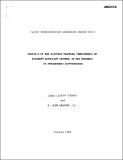Analysis of the altitude tracking performance of aircraft-autopilot systems in the presence of atmospheric disturbances
Author(s)
Sturdy, James Luckett; Hansman, Robert John.
DownloadFTL_R_1988_01.pdf (3.016Mb)
Other Contributors
Massachusetts Institute of Technology. Flight Transportation Laboratory
Massachusetts Institute of Technology. Dept. of Aeronautics and Astronautics
Metadata
Show full item recordAbstract
The dynamic response of aircraft-autopilot systems to atmospheric disturbances was investigated by analyzing linearized models of aircraft dynamics and altitude hold autopilots. Four jet aircraft (Boeing 737-100, McDonald Douglas DC9-30, Lockheed L-10ll, and Cessna Citation III) were studied at three flight levels (FL290, FL330, and FL370). The models were analyzed to determine the extent to which pressure surface fluctuations, vertical gusts, and horizontal gusts cause assigned altitude deviations by coupling with the aircraft-autopilot dynamics. The results of this analysis were examined in light of meteorological data on disturbance magnitudes and wavelengths collected from observations of mountain wave activity. This examination revealed that atmospheric conditions do exist which can cause aircraft to exhibit assigned altitude deviations in excess of 1,000 ft. Pressure surface fluctuations were observed to be the dominant source of altitude errors in flights through extreme mountain wave activity. Based on the linear analysis the maximum tolerable pressure surface fluctuation amplitude was determined as a function of wavelength for an allowable altitude error margin of 300 ft. The results of this analysis provide guidance for the determination of vertical separation standards in the presence of atmospheric disturbances.
Description
Cover title January 1988 Also issued as an M.S. thesis, Massachusetts Institute of Technology, Dept. of Aeronautics and Astronautics, 1988 Includes bibliographical references (p. 99)
Date issued
1988Publisher
[Cambridge, Mass. : Massachusetts Institute of Technology], Flight Transportation Laboratory, [1988]
Other identifiers
29296832
Series/Report no.
FTL report (Massachusetts Institute of Technology. Flight Transportation Laboratory) ; R88-1
Keywords
Airplanes, Automatic pilot (Airplanes), Altitudes, Atmospheric turbulence, Radar air traffic control systems, Control systems